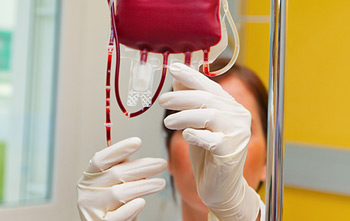
Blood Substitutes
Those early attempts were usually fatal, since scientists had not yet discovered blood types; nor did they have available the transfusion technologies and techniques we now take for granted.
Today, FDA’s Center for Biologics Evaluation and Research (CBER) is responsible for ensuring that blood and blood products used for transfusions in the United States are safe and effective. But sometimes blood is simply not available in certain extreme situations, such as accidents or battlefield trauma, or in certain cases of blood incompatibility.
For the last 30 years, scientists in industry and academic institutions have been trying to develop a portable blood substitute that:
- functions as an oxygen carrier in life-threatening situations;
- is stable enough to be stored for prolonged periods in different conditions;
- and, can be used to treat individuals of any blood type.
Hemoglobin, a protein in red blood cells, is the molecule available to carry oxygen in the human body. Hemoglobin contains the common element iron, which makes it possible for hemoglobin to capture and hold oxygen when red blood cells circulate through the lungs. When the iron in hemoglobin releases oxygen in the tissues, it becomes more prone to a chemical reaction called “oxidation.” Oxidation prevents further binding of oxygen to the iron and the resultant effect on hemoglobin can lead to cellular damage. (We call the result of this reaction “rusting” when it happens to an iron object.) Fortunately, red blood cells contain an enzyme system that prevents oxidation. As a result, oxygen can reversibly bind to the iron on hemoglobin in red blood cells.
But this enzyme system is not available when hemoglobin is removed from red blood cells and becomes “free hemoglobin,” which is used to carry oxygen in the blood substitute products evaluated so far, known as hemoglobin-based oxygen carriers (HBOCs). Iron oxidation is not reversed resulting in the destruction of hemoglobin itself as well as other molecules in the body’s surrounding tissues.
In addition HBOCs have also been associated with severe medical complications, such as high blood pressure, heart attacks and strokes. FDA scientists and others are trying to solve this problem so that safe and effective hemoglobin-based oxygen carriers can finally be brought to market.
We have experimented with molecules available in nature in an attempt to block free hemoglobin’s destructive chemical reactions within the body. One such molecule is haptoglobin, a naturally-occurring protein in the blood that prevents the damaging reactions of hemoglobin when it is present outside red cells. Our work suggests that it might be possible to control or reverse the toxic effects of free hemoglobin by transfusing patients with haptoglobin at the same time they are transfused with a hemoglobin-based oxygen carrier. We also showed that Vitamin C (ascorbic acid), a natural anti-oxidant, might also To have this protective effect.
To read the original article from the FDA website CLICK HERE.

